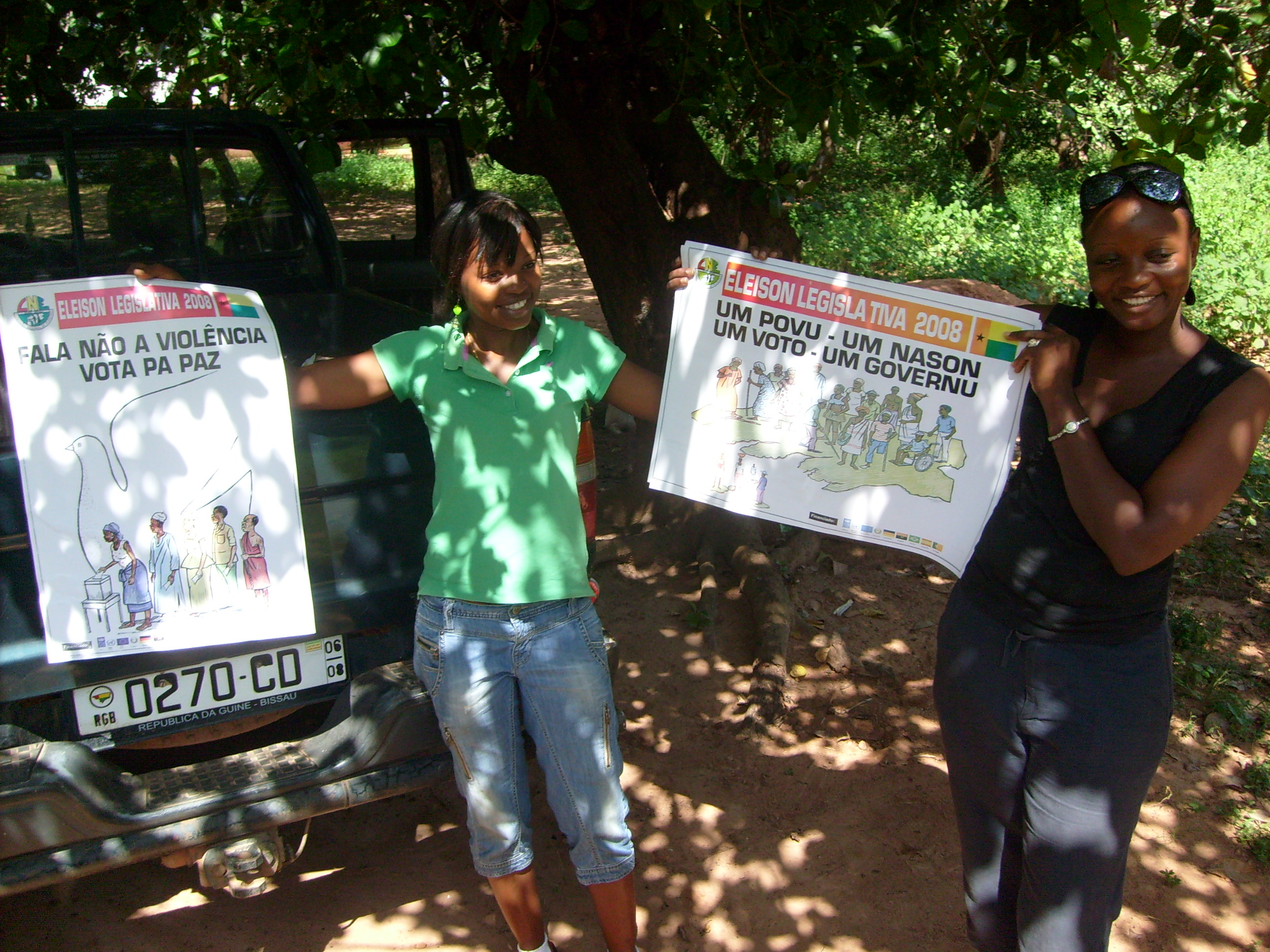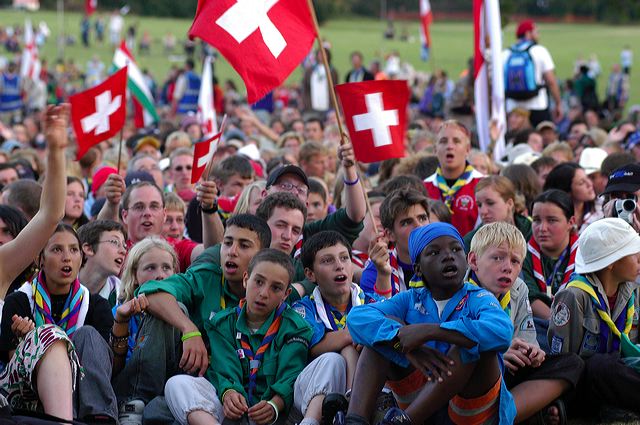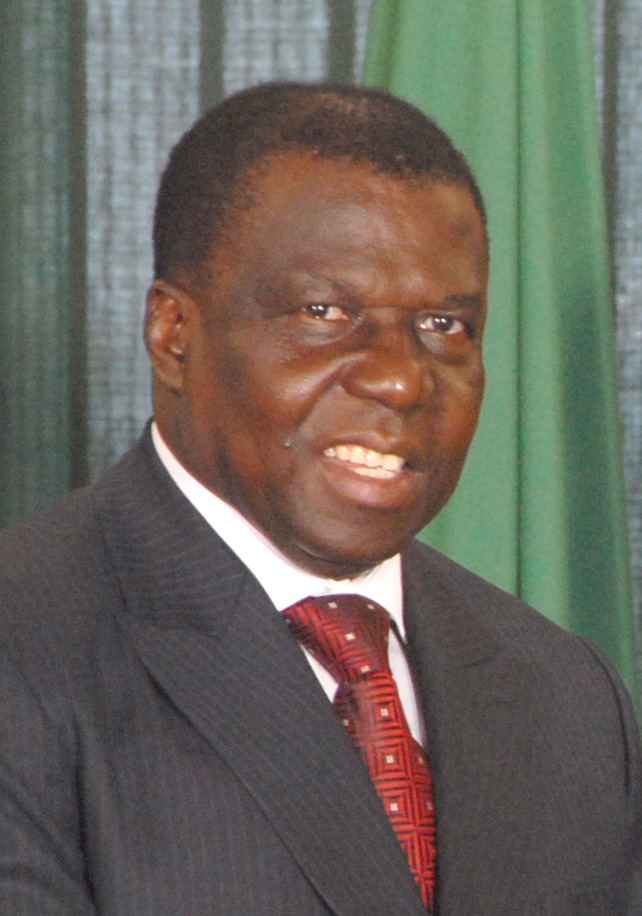|
Super Mama Djombo
Super Mama Djombo is a band from Guinea Bissau who sing in Guinea-Bissau Creole. The band was formed in the mid-1960s, at a Boy Scout camp, when the members were only children (the youngest was six years old). Mama Djombo is the name of a spirit that many fighters appealed to for protection during Guinea-Bissau's War of Independence. In 1974, the politically conscious band leader Adriano Atchutchi joined. The group became immensely popular in the young country, which had gained its independence the same year. They would often play at President Luís Cabral's public speeches, and their concerts were broadcast live on radio. In 1978, the group traveled to Cuba and appeared on the eleventh youth music festival in Havana. Early in 1980, they went to Lisbon and recorded six hours of material. The first album ''Na cambança'' was released the same year, and the song ''Pamparida,'' which was based on a children's song, became a huge hit throughout West Africa. In 1980 Cabral was ov ... [...More Info...] [...Related Items...] OR: [Wikipedia] [Google] [Baidu] |
Guinea Bissau
Guinea-Bissau ( ; pt, Guiné-Bissau; ff, italic=no, 𞤘𞤭𞤲𞤫 𞤄𞤭𞤧𞤢𞥄𞤱𞤮, Gine-Bisaawo, script=Adlm; Mandinka: ''Gine-Bisawo''), officially the Republic of Guinea-Bissau ( pt, República da Guiné-Bissau, links=no ), is a country in West Africa that covers with an estimated population of 1,726,000. It borders Senegal to the north and Guinea to the south-east. Guinea-Bissau was once part of the kingdom of Kaabu, as well as part of the Mali Empire. Parts of this kingdom persisted until the 18th century, while a few others were under some rule by the Portuguese Empire since the 16th century. In the 19th century, it was colonised as Portuguese Guinea. Portuguese control was restricted and weak until the early 20th century with the pacification campaigns, these campaigns solidified Portuguese sovereignty in the area. The final Portuguese victory over the remaining bastion of mainland resistance, the Papel ruled Kingdom of Bissau in 1915 by the Portugu ... [...More Info...] [...Related Items...] OR: [Wikipedia] [Google] [Baidu] |
Gumbé
Gumbe, also ''goombay'' or ''gumbay'', is a West African style of music found in countries such as Sierra Leone and Guinea-Bissau. Sierra Leonean gumbe music is indigenous to the Sierra Leone Creole people and was derived from the Jamaican Maroon ancestors of the Creole people. Creole musicians such as Ebenezer Calendar and Dr Oloh popularized gumbe music in Sierra Leone and in other West African locales. Etymology It is likely that the etymology of African-American musical genres goombay of the BahamasSee the ''Bahamas Goombay 1951-1959'' album (scroll down to read booklet in both French and English:/ref> originates in Guinea-Bissau gumbe. Gombey music from Bermuda and the Jamaican square maroon drum called goombay could also be related. Origins Gumbe is a specific genre, mostly influenced by the fast tempo Zouk (musical movement), zouk style called "zouk béton" (music of the French Caribbean popularized by Kassav in the 1980s); though the same term also refers to any musi ... [...More Info...] [...Related Items...] OR: [Wikipedia] [Google] [Baidu] |
Guinea-Bissau Creole
Guinea-Bissau Creole, also known as Kiriol or Crioulo, is a creole language whose lexicon derives mostly from Portuguese. It is spoken in Guinea Bissau, Senegal and The Gambia. It is also called by its native speakers as , , or . Guinea-Bissau Creole is spoken as a native tongue by 250,000 Bissau-Guineans and as a second language by 1,000,000. A variant of Guinea-Bissau Creole is also spoken in southern Senegal, mainly in the region of Casamance, a former Portuguese colony, which is known as Portuguis Creole or Casamance Creole. Creole is the majority language of the inhabitants of the Casamance region and is used as a language of commerce. Standard Portuguese is the official language of Guinea-Bissau, but Guinea-Bissau Creole is the language of trade, informal literature and entertainment. It is not used in either news media, parliament, public services or educational programming. History The creole languages of Upper Guinea are the oldest-known creoles whose lexicons derive ... [...More Info...] [...Related Items...] OR: [Wikipedia] [Google] [Baidu] |
Boy Scout
A Scout (in some countries a Boy Scout, Girl Scout, or Pathfinder) is a child, usually 10–18 years of age, participating in the worldwide Scouting movement. Because of the large age and development span, many Scouting associations have split this age group into a junior and a senior section. Scouts are organized into troops averaging 20–30 Scouts under the guidance of one or more Scout Leaders or Scoutmasters. Troops subdivide into patrols of about 6–8 Scouts and engage in outdoor and special interest activities. Troops may affiliate with local, national, and international organizations. Some national Scouting associations have special interest programs such as Air Scouts, Sea Scouts, outdoor high adventure, Scouting bands, and rider Scouts. Foundation After the Second Boer War boys showed considerable interest in ''Aids to Scouting'', a book about military scouting and wilderness survival written by a hero from that war, Robert Baden-Powell. The book was also used by te ... [...More Info...] [...Related Items...] OR: [Wikipedia] [Google] [Baidu] |
National Geographic (magazine)
''National Geographic'' (formerly the ''National Geographic Magazine'', sometimes branded as NAT GEO) is a popular American monthly magazine published by National Geographic Partners. Known for its photojournalism, it is one of the most widely read magazines of all time. The magazine was founded in 1888 as a scholarly journal, nine months after the establishment of the society, but is now a popular magazine. In 1905, it began including pictures, a style for which it became well-known. Its first color photos appeared in the 1910s. During the Cold War, the magazine committed itself to present a balanced view of the physical and human geography of countries beyond the Iron Curtain. Later, the magazine became outspoken on environmental issues. Since 2019, controlling interest has been held by The Walt Disney Company. Topics of features generally concern geography, history, nature, science, and world culture. The magazine is well known for its distinctive appearance: a thick squa ... [...More Info...] [...Related Items...] OR: [Wikipedia] [Google] [Baidu] |
Guinea-Bissau War Of Independence
The Guinea-Bissau War of Independence (), or the Bissau-Guinean War of Independence, was an armed independence conflict that took place in Portuguese Guinea from 1963 to 1974. It was fought between Portugal and the African Party for the Independence of Guinea and Cape Verde (''Partido Africano da Independência da Guiné e Cabo Verde,'' PAIGC), an armed independence movement backed by Cuba, the Soviet Union, and Yugoslavia. The war is commonly referred to as "Portugal's Vietnam" because it was a protracted guerrilla war which had extremely high costs in men and materiel and which created significant internal political turmoil in Portugal. After the assassination of PAIGC leader Amílcar Cabral in January 1973, the military conflict reached a stalemate: Portuguese forces were largely confined to major cities and various fortified bases and were patently unable to dislodge PAIGC from the so-called liberated zones. In September 1973, the PAIGC-dominated People's National Assembly u ... [...More Info...] [...Related Items...] OR: [Wikipedia] [Google] [Baidu] |
Luís Cabral
Luís Severino de Almeida Cabral (11 April 1931 – 30 May 2009) was a Bissau-Guinean politician who was the first President of Guinea-Bissau. He served from 1974 to 1980, when a military ''coup d'état'' led by João Bernardo Vieira deposed him. Luís Cabral was a half-brother of Amílcar Cabral, with whom he co-founded the African Party for the Independence of Guinea and Cape Verde (PAIGC) in 1956. Early life Luís Cabral was born in the city of Bissau, Portuguese Guinea, on April 11, 1931 to mestiço (mixed-race) parents originally from the Cape Verde. He completed his primary school studies in the Cape Verde archipelago, which was also a Portuguese territory at that time. Later he received training in accountancy.Morreu Luís Cabral, primeiro presidente da Guiné-Bissa ... [...More Info...] [...Related Items...] OR: [Wikipedia] [Google] [Baidu] |
Cuba
Cuba ( , ), officially the Republic of Cuba ( es, República de Cuba, links=no ), is an island country comprising the island of Cuba, as well as Isla de la Juventud and several minor archipelagos. Cuba is located where the northern Caribbean Sea, Gulf of Mexico, and Atlantic Ocean meet. Cuba is located east of the Yucatán Peninsula (Mexico), south of both the American state of Florida and the Bahamas, west of Hispaniola ( Haiti/Dominican Republic), and north of both Jamaica and the Cayman Islands. Havana is the largest city and capital; other major cities include Santiago de Cuba and Camagüey. The official area of the Republic of Cuba is (without the territorial waters) but a total of 350,730 km² (135,418 sq mi) including the exclusive economic zone. Cuba is the second-most populous country in the Caribbean after Haiti, with over 11 million inhabitants. The territory that is now Cuba was inhabited by the Ciboney people from the 4th millennium BC with the Gua ... [...More Info...] [...Related Items...] OR: [Wikipedia] [Google] [Baidu] |
Havana
Havana (; Spanish: ''La Habana'' ) is the capital and largest city of Cuba. The heart of the La Habana Province, Havana is the country's main port and commercial center.Cuba ''''. . The city has a population of 2.3million inhabitants, and it spans a total of – making it the largest city by area, the most populous city, and the [...More Info...] [...Related Items...] OR: [Wikipedia] [Google] [Baidu] |
Lisbon
Lisbon (; pt, Lisboa ) is the capital and largest city of Portugal, with an estimated population of 544,851 within its administrative limits in an area of 100.05 km2. Grande Lisboa, Lisbon's urban area extends beyond the city's administrative limits with a population of around 2.7 million people, being the List of urban areas of the European Union, 11th-most populous urban area in the European Union.Demographia: World Urban Areas - demographia.com, 06.2021 About 3 million people live in the Lisbon metropolitan area, making it the third largest metropolitan area in the Iberian Peninsula, after Madrid and Barcelona. It represents approximately 27% of the country's population. [...More Info...] [...Related Items...] OR: [Wikipedia] [Google] [Baidu] |
João Bernardo Vieira
João Bernardo "Nino" Vieira (; 27 April 1939 – 2 March 2009) was a Bissau-Guinean politician who was the President of Guinea-Bissau from 1980 to 1999, except for a three-day period in May 1984, and from 2005 to 2009. After seizing power from President Luís Cabral in a military coup in 1980, Vieira ruled as part of the Military Council of the Revolution until 1984, when civilian rule was returned. Opposition parties were allowed in 1991, and Vieira won a multiparty presidential election in 1994. He was ousted at the end of the 1998–1999 civil war and went into exile. He made a political comeback in 2005, winning that year's presidential election. Vieira was killed by soldiers on 2 March 2009, apparently in retaliation for a bomb blast that killed Guinea-Bissau's military chief General Batista Tagme Na Waie hours before. The military officially denied these allegations after unidentified Army officials claimed responsibility of Vieira for Na-Waie's death. Viei ... [...More Info...] [...Related Items...] OR: [Wikipedia] [Google] [Baidu] |
Flora Gomes
Flora Gomes is a Bissau-Guinean film director. He was born in Cadique, Guinea-Bissau on 31 December 1949 and after high school in Cuba, he decided to study film at the Instituto Cubano del Arte y la Industria Cinematográficos in Havana. Shot fourteen years after Guinea-Bissau#Independence (1973), independence, Gomes's ''Mortu Nega'' (''Death Denied'') (1988) was the first fiction film and the second feature film ever made in Guinea-Bissau. (The first feature film was ''N’tturudu'', by director Umban u’Kest in 1987.) At FESPACO 1989, the film won the prestigious Oumarou Ganda Prize. ''Mortu Nega'' is in Creole with English language, English subtitles. In 1992, Gomes directed ''Udju Azul di Yonta'', which was screened in the Un Certain Regard section at the 1992 Cannes Film Festival. Biography Son of literacy, illiterate parents, as a child Gomes struggled against the limitations of his social status and the oppression of the Portuguese Empire, Portuguese colonial system unde ... [...More Info...] [...Related Items...] OR: [Wikipedia] [Google] [Baidu] |






